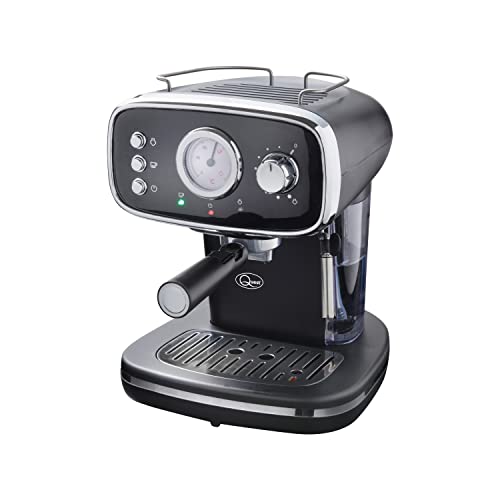How to Make Espresso Machine Coffee
Espresso machines can produce an excellent cup of coffee, but they require more maintenance and setup than a typical coffee maker. You'll also need to grind and tamp the beans by yourself.
Pressure is a key element in making espresso. Here's how an espresso machine works: a heating vessel warms water to the perfect temperature, then it pushes it through the grounds before pouring out the spouts.
Temperature
Espresso is produced by forcing hot water through finely ground coffee. The temperature of the water is vital to the final shot. Low temperatures result in under extraction of the essential flavor compounds. italian espresso machines cause excessive extraction, which can result in burnt or bitter flavors.
The ideal temperature for espresso is between 195 and 205degF. This temperature can be achieved by using a grouphead that is designed to ensure the same temperature and stability throughout the brewing process. The E61 is the most popular group head as it provides temperature stability, pre-infusion capabilities and lever control.
It is essential to take into account the temperature when you adjust your espresso machine for different roasts or brew ratios. This can impact the extraction yield as well as the crema. The ideal temperature will vary on the particular roast and beans however, the general rule is that lighter roasts and greater ratios of brews need higher temperatures than dark roasts and lower brew ratios. In addition, a good quality thermocouple will be essential to ensure a constant temperature.
Pressure

During the brewing procedure, espresso machine coffee is pushed through finely ground coffee grounds that have been stamped. This creates chemical reactions that extract flavors, oils and other soluble components from the beans. The resultant beverage is usually richer and more flavorful than regular coffee.
The ideal espresso machine pressure should be nine bar, which is equivalent to the atmospheric pressure at sea level. The soluble compounds in the coffee bean are best extracted at this pressure.
However some espresso machines advertise 15 or 20 bars of pressure. While these machines are able to attain these levels of pressure but they might not be capable of maintaining the pressure level throughout the extraction.
One bar of pressure equals to 32 pounds per square inch (PSI) of a car's tire. It's more than four-times the pressure a professional cyclist uses to pump up their bike tires. The ability to control espresso machine's pressure and make consistent espressos is the key to any serious home barista.
Water
Water is an essential ingredient to a perfect cup of espresso. The correct water will allow your beans to extract their maximum potential. However the wrong water can cause problems like clogging pipes and even damage your expensive machine.
The best choice is a natural spring water that is rich in minerals to ensure optimum espresso extraction. This water will enhance the taste of your espresso without the chalky mineral trace that is found in tap water or bottled water. This is an excellent alternative to reverse osmosis, which could be too pure and cause issues with flavor.
It is not recommended to utilize a water filtration device that removes the mineral content of the water you drink. This can lead to flavor and extraction issues. Buy a water testing kit to determine the average hardness of your local water. This can be used to identify a filtration system that will provide the right water requirements for your espresso machine.
Beans
Most coffee aficionados tend to be very involved in the entire process of making espresso. They are obsessed with a range of variables, including temperature, pressure of water, beans, milk, viscosity and other factors. If one factor is slightly off, the whole shot may be sour.
The most important thing to consider in the matter of espresso is the beans used. People generally believe that only certain kinds of beans work well to be used in espresso. While certain beans are suited for certain purposes however, any bean that has been roasted can be used to make espresso. The difference between espresso beans and regular coffee beans is that espresso beans are roasted for longer in tipycally, well past the second crack, which gives them their darker appearance and makes them more soluble in water.
The best beans for espresso are generally medium roasted or dark roasted, giving the shots that distinctive richness and boldness. Light roasted beans can also be used to make excellent espresso, particularly when they are ground prior to use for ease of use in an espresso maker.
Milk
Espresso and milk is a traditional combination. The combination of milk and espresso is a classic. Not only does it improve energy levels, but it also balances the bitterness of the espresso. This is one of the most delicious culinary pairings!
When selecting an espresso maker capable of making latte, or a cappuccino as well it is important to consider the ease to use. Many of the best machines come with a jug for hot or cold coffee and a steam wand. They also come with a portafilter to pull the shot. Some models also come with a built-in grinder as well as a tamper and a frother.
To get rid of any condensed liquid, the steam wand must be purged each day before use (or after each cup of espresso). The process takes around 30 seconds and is important to ensure that your machine runs smoothly. Failure to cleanse could result in bitter taste or a build-up of bacteria which can alter the taste and smell of your beverages. It's easy to do and should be part of your regular maintenance routine.
